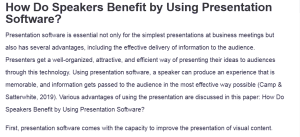How Do Speakers Benefit by Using Presentation Software?
Presentation software is essential not only for the simplest presentations at business meetings but also has several advantages, including the effective delivery of information to the audience. Presenters get a well-organized, attractive, and efficient way of presenting their ideas to audiences through this technology. Using presentation software, a speaker can produce an experience that is memorable, and information gets passed to the audience in the most effective way possible (Camp & Satterwhite, 2019). Various advantages of using the presentation are discussed in this paper: How Do Speakers Benefit by Using Presentation Software?
First, presentation software comes with the capacity to improve the presentation of visual content. From experience and research, visuals are effective in capturing and sustaining an audience’s attention (Hariharasudan et al., 2021). Currently, Microsoft PowerPoint, Google Slides, and Prezi help speakers to include slides with images, charts, graphs, or videos.
They aid in the development of ideas and make them clear and easy for the audience to comprehend. For example, using a pie chart, one can quickly describe the overall financial situation or depict statistics that words can hardly describe. Through the provision of context, a speaker can productively assist in enhancing the audience’s capture of the message since the context is well-elaborated.
Second, presentation software enables speakers to organize their content logically and systematically. Features like templates and slide designs allow the material to be presented coherently. The provision of reference information divided into visible sections allows the speakers to adhere to the rational thought process, which is captivating and does not overload the viewer. Furthermore, the features of previewing the introduced slides and their repositioning guarantee that the presentation conforms to the goals set by the speaker, thus making it possible to highlight critical aspects and avoid experimental notions and concepts.
Third, the presenter needs to capture the audience’s attention, a functionality well-catered for by presentation software. Animations are useful to make an experience more engaging and often assist in focusing the audience’s attention at appropriate moments. Additionally, polls and quizzes that are normally included in continuous broadcasting assist in compelling the listeners to be active during the presentation. Further, audiovisual components such as videos can be included in the presentation, giving the audience some relief from too much-spoken content.
Fourth, presentation software allows for extensive customization, enabling speakers to tailor their visuals to the audience. The presenter can select the type of fonts that match the company’s brands or the mood that must be set during the presentation. The presenter can also use colors and graphics to achieve a professional look on the slides. Notably, this makes the presentation far more engaging because the audience can identify with the speaker a lot more easily.
Finally, making a presentation may take a lot of time, but with presentation software, the process is easier. Modern templates and designing aids save much time while preparing presentations. Essentially, this efficiency enables the speakers to spend more time on proper content delivery than having to devote much time to the designing process.
Overall, well-selected presentation software provides a lot of advantages for speakers. It facilitates visualization, helps structure the presentation, and gets an audience’s attention due to its ability to offer customization, save time, and be easily accessed. Notably, this makes it an ideal tool for enhancing the creation of effective and persuasive presentations. The application of the presentation software’s opportunities helps speakers enhance their activity, make a strong impression on the audience, and achieve the communication objectives.
References
Camp, S. C., & Satterwhite, M. L. (2019). College English and business communication (11th ed.). McGraw Hill Education
Hariharasudan, A., Rahiman, H. U., Nawaz, N., & Panakaje, N. (2021). Strategic influence of business English in management education. Polish Journal of Management Studies, 23(2), 180-195. https://ssrn.com/abstract=3880590
ORDER A PLAGIARISM-FREE PAPER HERE
We’ll write everything from scratch
Question 
- How do speakers benefit by using presentation software?

How Do Speakers Benefit by Using Presentation Software?